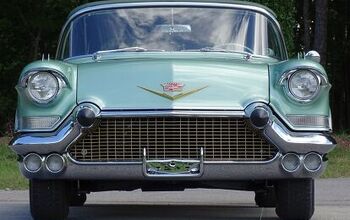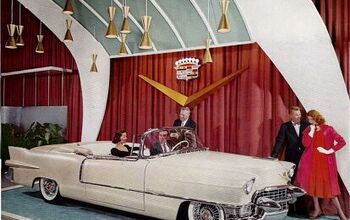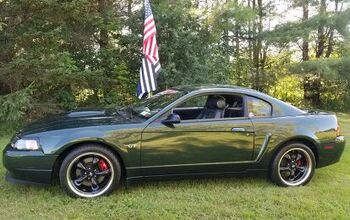Editorial: The Battle At Midday. How America Can Win The War Against GM

Informa Global Markets (IGM) “is a world-class international supplier of real-time news and analysis to market professionals in the fields of foreign exchange, sovereign fixed income and corporate bonds.” It’s the stuff brokerage houses and investment bankers pay a lot of money for in order to look smart with their clients. Would definitely bust TTAC’s budget. Some of my friends in high finance still hold a job, and one of them (you know who you are) was nice enough to forward me yesterday’s IGM “Markets At Midday” issue. Reads like “Markets At Midway.” With the appropriate ending: The bad guys lose.
The issue deals with – you guessed it – our least favorite topic: GM. And what a blow it deals. The usually dryly written report starts with a headline that could have been typed by a tasteless scribe like yours truly: “Forget The TARP, Get A Body Bag”
The piece chronicles yesterday’s plummeting GM share price; it sank to a low not seen since the last Great Depression. It continued to fall to a penny off its all-time historical low: $1.69. That’s what a share of GM was worth on June 4, 1938 (a Hershey bar went for a nickel the same year.) The report further recounts yesterday’s rebound– to $3– on the news that a bipartisan group of Senators from states afflicted by the motor malaise reached a tentative deal on a bailout package. Three bucks a share would have bought 30 packs of Oreos in 1938; we’re talking major value here.
The analyst, and they are paying them big bucks for taking a contrarian view, doesn’t share the newfound optimism that rallied the share. The writer singles-out United Auto Workers boss Ron Gettelfinger. (We take a somehow broader approach, but hey, it’s still a free country.)
“Consider these ironies. According to Mr Gettelfinger, it takes 78 workers to produce 2,500 cars at GM, while at foreign manufacturer’s plant it only involves 33 workers. According to one auto analyst, last year when GM closed a plant in Linden,NJ, they were obligated to carry those idled workers on the payroll for an additional 40 days. It is estimated that every single car that rolls off the assembly line costs US automakers $1,500 to $2,000 in legacy costs.
“Why? Because of the same Mr. Gettelfinger who is figuratively blackmailing the government into expanding the parameters of TARP. The same Mr. Gettelfinger who, while wanting the taxpayers to save the Big Three, is unwilling to renegotiate terms of the union contracts. The same Mr. Gettelfinger who, over the years, has sucked the US auto industry dry to the point that you can no longer get blood from a stone.”
Gettelfinger doesn’t appear to be on the analyst’s Christmas list. And v.v. As bad as it is, all is not lost. Apparently.
“But while there is strong opposition on Capitol Hill to dip into the already-approved loan to jump-start the green, fuel efficient initiative, there are certainly others ways that, if absolutely necessary as Mr Gettelfinger maintains, to, not bail out, but lend aid to the auto industry mired in 20 years worth of mistakes.”
Unlike three private-jet-friendly CEOs we could name, the analyst has a plan to save the industry while appeasing those who are against “lending a helping hand to an industry that has literally driven itself into the ground.” He lays down five “suggestions and requirements for the automakers to receive $25b in aid.”
1) “Let them declare bankruptcy before handing over a dime.” It would keep GM alive, and allow them to reorganize, renegotiate contracts and raise capital. The latter would be a bit tricky, given the dire straits of the credit market. Hence the government loan.
2) “Let, or force, GM and Chrysler, or better yet, all three, to merge.” Cut costs, workforce and eliminate a glut of non-selling models.
3) “Replace top management at all three automakers with turnaround specialists.” Specialists with a proven track record. A track record which the analyst says the current executives don’t have. In other words: Fire them.
4) “Trim the workforce to the level of their foreign competitors (33 versus 78 per vehicle).” This in a last ditch effort to “save most of the 3m jobs that Mr. Gettelfinger says would be lost.”
5)”Instead of trusting the automakers to make good use of the $25b, a government-appointed trustee should dole out the funds.” Some of the bailout bucks should go to dealerships to keep them afloat. Some should be used for a buyer incentive program (the discriminating, but non-discriminatory writer suggests $3k for a hybrid and $1k for a Tahoe.) Some should go into a government-guaranteed warranty program “to quell the fears of consumers buying a vehicle from a bankrupt company.” (Think FDIC for cars.) And, finally, “Take the liability of the pension and health care expenses of retirees off the hands of the automakers.”
[Unwritten, but obvious to the not so innocent bystander amongst IGM’s subscribers in the sovereign funds and private equity field:a company that underwent all five of the above would be a very juicy target for people with real money.]
“Don’t forget the toe tag,” the analyst’s piece ends.
Minutes later, the report was on the desks of market professionals in the fields of foreign exchange, sovereign fixed income and corporate bonds. But even as the analyst typed his last lines (remember, it was a mid-day report), the news broke that the bipartisan boondoggle was dead. GM’s stock promptly shed several Oreo packs (at 1938 prices) and closed at $2.88.

Bertel Schmitt comes back to journalism after taking a 35 year break in advertising and marketing. He ran and owned advertising agencies in Duesseldorf, Germany, and New York City. Volkswagen A.G. was Bertel's most important corporate account. Schmitt's advertising and marketing career touched many corners of the industry with a special focus on automotive products and services. Since 2004, he lives in Japan and China with his wife <a href="http://www.tomokoandbertel.com"> Tomoko </a>. Bertel Schmitt is a founding board member of the <a href="http://www.offshoresuperseries.com"> Offshore Super Series </a>, an American offshore powerboat racing organization. He is co-owner of the racing team Typhoon.
More by Bertel Schmitt
Latest Car Reviews
Read moreLatest Product Reviews
Read moreRecent Comments
- Flashindapan Will I miss the Malibu, no. Will I miss one less midsize sedan that’s comfortable, reliable and reasonably priced, yes.
- Theflyersfan I used to love the 7-series. One of those aspirational luxury cars. And then I parked right next to one of the new ones just over the weekend. And that love went away. Honestly, if this is what the Chinese market thinks is luxury, let them have it. Because, and I'll be reserved here, this is one butt-ugly, mutha f'n, unholy trainwreck of a design. There has to be an excellent car under all of the grotesque and overdone bodywork. What were they thinking? Luxury is a feeling. It's the soft leather seats. It's the solid door thunk. It's groundbreaking engineering (that hopefully holds up.) It's a presence that oozes "I have arrived," not screaming "LOOK AT ME EVERYONE!!!" The latter is the yahoo who just won $1,000,000 off of a scratch-off and blows it on extra chrome and a dozen light bars on a new F150. It isn't six feet of screens, a dozen suspension settings that don't feel right, and no steering feel. It also isn't a design that is going to be so dated looking in five years that no one is going to want to touch it. Didn't BMW learn anything from the Bangle-butt backlash of 2002?
- Theflyersfan Honda, Toyota, Nissan, Hyundai, and Kia still don't seem to have a problem moving sedans off of the lot. I also see more than a few new 3-series, C-classes and A4s as well showing the Germans can sell the expensive ones. Sales might be down compared to 10-15 years ago, but hundreds of thousands of sales in the US alone isn't anything to sneeze at. What we've had is the thinning of the herd. The crap sedans have exited stage left. And GM has let the Malibu sit and rot on the vine for so long that this was bound to happen. And it bears repeating - auto trends go in cycles. Many times the cars purchased by the next generation aren't the ones their parents and grandparents bought. Who's to say that in 10 years, CUVs are going to be seen at that generation's minivans and no one wants to touch them? The Japanese and Koreans will welcome those buyers back to their full lineups while GM, Ford, and whatever remains of what was Chrysler/Dodge will be back in front of Congress pleading poverty.
- Corey Lewis It's not competitive against others in the class, as my review discussed. https://www.thetruthaboutcars.com/cars/chevrolet/rental-review-the-2023-chevrolet-malibu-last-domestic-midsize-standing-44502760
- Turbo Is Black Magic My wife had one of these back in 06, did a ton of work to it… supercharger, full exhaust, full suspension.. it was a blast to drive even though it was still hilariously slow. Great for drive in nights, open the hatch fold the seats flat and just relax.Also this thing is a great example of how far we have come in crash safety even since just 2005… go look at these old crash tests now and I cringe at what a modern electric tank would do to this thing.


































Comments
Join the conversation
If the recession continues, especially if a depression arises, and it lasts long enough, i expect more folks to lose their housing, even if they are renting. Watch van and pick-up sales rise, new and used. Also watch small travel trailer and camper shell/topper/whatever term used in thine area to increase. Gym memberships, the basic low-cost type, will increase so folks have a place to clean up. Dumpster diving will become a family activity. Long-term low-cost parking firms may also benefit as folks seek places to park and sleep where the jack-booted thugs will not roust them. Anything is better than being truly homeless... and living in a vehicle IS better than a homeless shelter or on the streets.
Can someone explain to me why it was OK for the government to essentially give away $500 billion to investment banks and insurance companies with no demands on management, employee, or shareholder compensation... http://www.bloomberg.com/apps/news?pid=20601087&sid=aVXfypExIZ9M ...but when the government is proposing to loan $25 billion to the Detroit 3 automakers, it is suddenly imperative that the union be smashed and the executives starved?